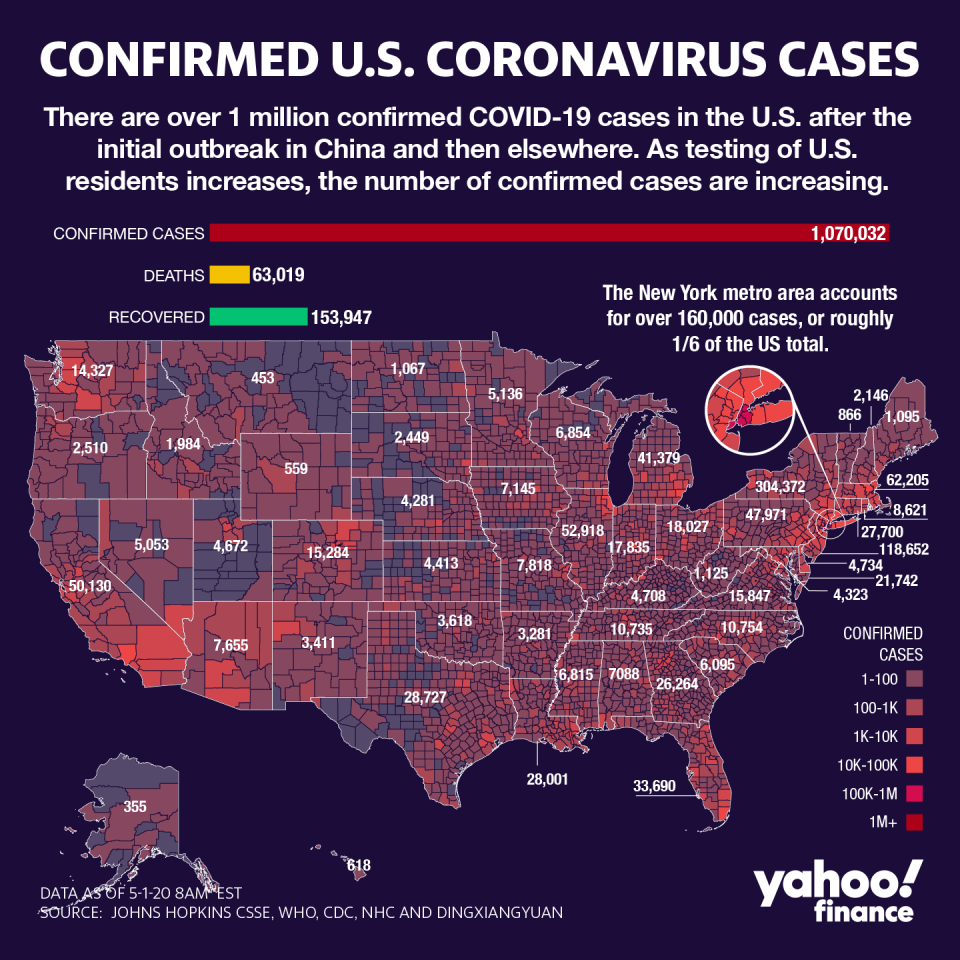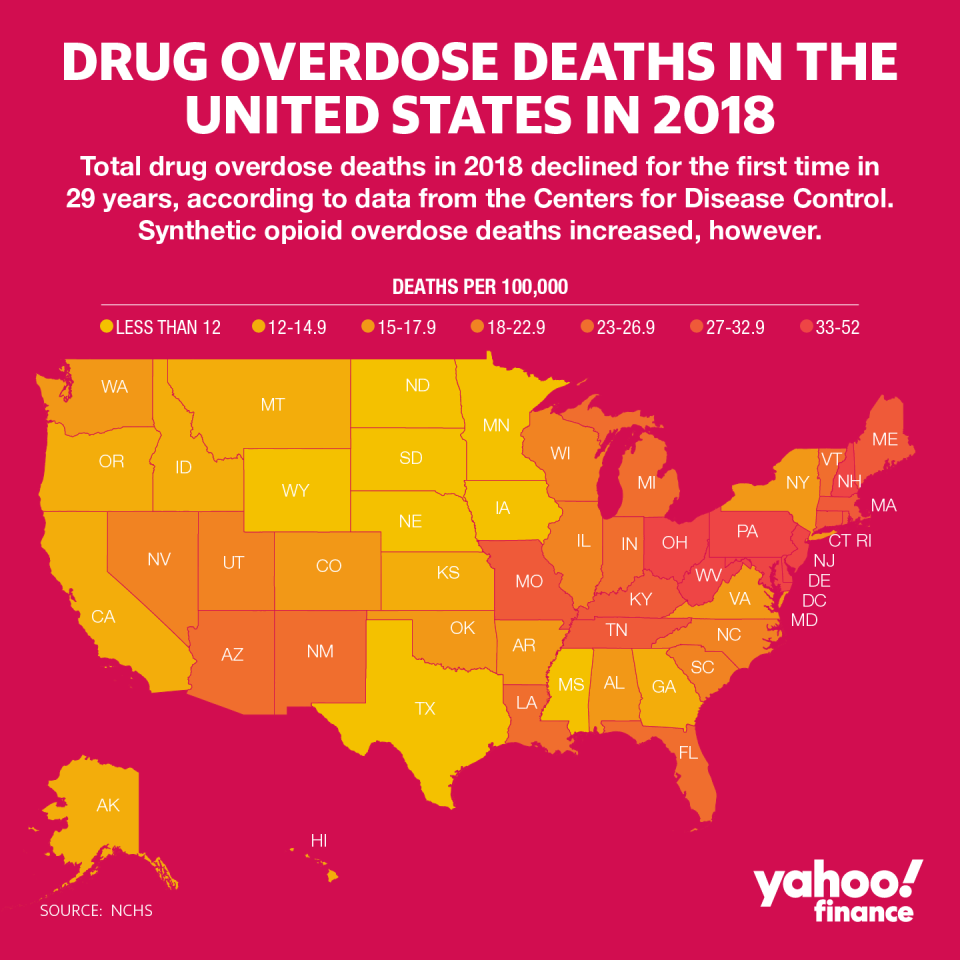Coronavirus pandemic 'threatens to make the opioid crisis substantially worse'
Over 1 million people in the U.S. have tested positive for COVID-19, the illness brought about by the coronavirus pandemic. Worldwide, there are over 3 million cases and over 230,000 deaths.
Social distancing measures and stay-at-home orders have been implemented across the country as a method of trying to contain the spread of the virus. But it could be having adverse effects on those who are struggling with substance use disorder and worsen the U.S. opioid crisis.
“The coronavirus pandemic threatens to make the opioid crisis substantially worse by hindering access to effective opioid use disorder treatment and increasing risks of addiction relapse and overdose,” Rebecca Haffajee, policy researcher at the RAND Corporation and professor at University of Michigan School of Public Health, told Yahoo Finance.

Haffajee co-authored a journal article for the Annals of Internal Medicine that detailed the specific effects of the pandemic on those seeking treatment for opioid use disorder.
“Although the pandemic threatens everyone, it is a particularly grave risk to the millions of Americans with opioid use disorder, who — already vulnerable and marginalized — are heavily dependent on face-to-face health care delivery,” the paper stated. “Rapid and coordinated action on the part of clinicians and policymakers is required if these threats are to be mitigated.”
‘Increasing risks of addiction relapse and overdose’
In 2018, there were 67,367 drug overdose deaths in the U.S., which was a 4.1% decline from the year prior, according to the CDC. It was the first decline in overdose deaths in 29 years. However, overdose deaths from synthetic opioids, like fentanyl, are continuing to rise.
And tens of millions of Americans losing their jobs could exacerbate that problem.
“We know that it’s been well-documented that when people lose their jobs, when people have major stresses in their lives, this all increases the at-risk population, and I think the pandemic fits in,” Tommy Begres, a firefighter paramedic based out of Michigan, told Yahoo Finance.

For those looking to seek treatment for their addiction, they may encounter more challenges than ever before due to social distancing measures.
“For persons already in treatment,” the paper noted, “one of the biggest threats is disruption of care.”
One example that Haffajee used is how these patients can’t attend peer support groups that may be critical to their recovery, because groups of large people are currently banned. It may also be difficult for these patients to obtain counseling from clinics or obtain their medications.
And for those that do go into clinics, they are at higher risk of experiencing serious complications if they contract COVID-19.
“They often suffer from other illnesses and social risk factors — like lack of adequate housing, nutrition, and health insurance,” Haffajee said. “Unpredictable access to treatment, together with increased stress, isolation, and housing and food insecurity all can trigger relapse and overdose.”
Some groups have come up with unique solutions to this challenge. For example in New Jersey, the state with the second-highest number of cases, the New Jersey Harm Reduction Coalition is collaborating with NEXT Naloxone to provide free naloxone by mail to those at high risk, such as those using drugs, who have recently stopped using drugs, people leaving treatment, and those who were recently incarcerated. Naloxone is used to reverse drug overdoses.

‘We had to respond in front of a grocery store’
There are also those who receive medication-assisted treatment, like buprenorphine and methadone.
These are typically administered under physician supervision, since the drugs can be dangerous if used improperly.
“Some federal policy changes should ease access to medication-assisted treatment during this COVID crisis,” Haffajee said. “Clinics can now give stable patients 14-28 days of take-home doses of medications (i.e., methadone) to treat opioid use disorder. Buprenorphine can now be prescribed remotely (including over the telephone) for new patients, removing the need for an initial in-person exam.”
These changes in treatment can throw off patients, however. This happened to someone that Begres encountered on a 911 call who had an accidental overdose.
“In the case of this individual, they would normally go to their medication-assisted treatment center every day to receive their dose for treatment therapy,” he said. “Unfortunately, in this situation, what had happened was … the centers were handing out multiple doses for them to take home and the individual thought they should take it three times a day now. Instead, they were supposed to take it over three days. Basically, we had to respond in front of a grocery store to assist that person.”
In the meantime, there are other ways for treatment programs to reduce demand for in-person care, as detailed in the Annals of Medicine article. Because of technology, medications can now be dispensed at home in an automated way that secures the pills, reminds people when to take them, and issues alerts to programs for when someone misses a dose or tampers with the device.
Video-based therapy is another kind of treatment program that’s becoming available. This provides video evidence for medical staff to see that their patient properly took their medication as prescribed.
But despite these innovative measures, Haffajee is still worried that overdoses will still be an issue during this pandemic.
“Because of disruptions in addiction treatment and increased risk factors at play during COVID-19, I expect that substance misuse and, by extension, overdose will increase,” Haffajee said. “The coronavirus’s economic and social devastation is likely to be long-lasting, which could exacerbate opioid- and other substance-related harms well beyond containment of the virus.”
Adriana is a reporter and editor for Yahoo Finance. Follow her on Twitter @adrianambells.
READ MORE:
A doctor explains 'the most surprising thing' about America's opioid crisis
How China flooded the U.S. with lethal fentanyl, fueling the opioid crisis
Read the latest financial and business news from Yahoo Finance
Follow Yahoo Finance on Twitter, Facebook, Instagram, Flipboard, SmartNews, LinkedIn, YouTube, and reddit.

 Yahoo Finance
Yahoo Finance 
